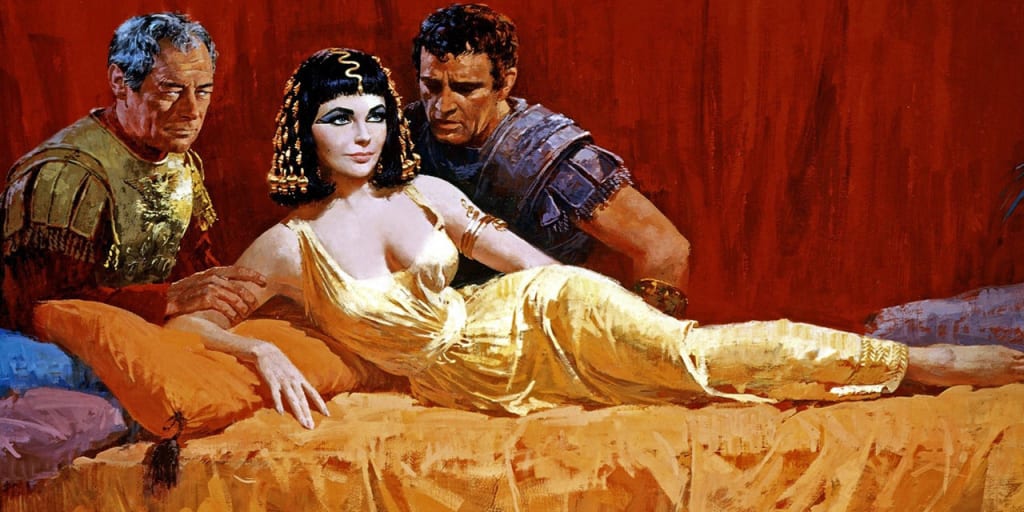Golden Age of Hollywood: Cleopatra (1963)
A Look at a Classic Film From a Modern Perspective

Cleopatra is a movie about an icon of ancient Egypt. The film stars an icon of the silver screen, Elizabeth Taylor and features a rich story with a complex plot. The story follows Cleopatras rise to becoming the Queen of the Nile until her death and is set at a time when Egypt was at a turning point in its civilization. The film influenced how we view ancient Egypt today, a monumental production using vibrant and elaborate sets, a star-studded cast and an immense number of extras.
Compared to the movies of today Cleopatra is quite long. At times the story can be very slow but that is half of its charm. The story of Cleopatra is now commonly known by most people. We learn it from a variety of sources from a young age, often without realizing it. It is integrated into cartoons and the narrative itself has been adapted with the characters changed so it can be used in other movies and series.
Julius Caesar (Rex Harrison) travels to Egypt to take control of the kingdom by becoming the executor of the estate of the father of the young Pharoah Ptolemy XIII (Richard O’Sullivan). Cleopatra (Elizabeth Taylor) is the older sister to the Pharoah and she persuades Caesar to remove her younger brother from his position and return the throne to her, making her the Queen of Egypt. An assassination plot is then made against Cleopatra by Pothinus (Gregoire Aslan). Pothinus is caught before Cleopatra can be assassinated and Pothinus is punished by being put to death. Ptolemy is then exiled into the desert and Cleopatra is crowned the queen of Egypt. This leads to Cleopatra becoming infatuated with power and she marries Caesar and together they have a son.
Caesar continues to have a deep desire to rule Rome and become the republics king. Eventually he rises to power becoming a dictator for life over the Republic. Caesar returns to Rome and takes power before having Cleopatra join him. Cleopatra arrives in Rome in a manner fit for a queen. The people of Rome seem to adore her and their admiration grows as she spends time in the city. The Roman Senate starts to get concerned about the affairs of Caesar and becomes discontent over the idea that he wants to become the king. Caesar is assassinated and a rebellion starts. The rebellion is quickly ended by Caesars inner circle which includes his adopted son Octavian and Mark Antony (Richard Burton). Afterwards the group loyal to Caesar splits the republic up between them. Cleopatra then becomes angry because in Caesars will, Octavian was made his successor instead of her son. This causes Cleopatra to return to Egypt.
A short time later Mark Antony requires finances and resources for an upcoming battle. He comes to the realization that the only place he can acquire what he requires is Egypt. Cleopatra is mandated to leave Egypt but refuses several times. Eventually she meets Mark Antony on her royal barge and they fall in love.
Antony then returns to Rome and gets married to Octavia the sister of Octavian. This allows him to advance his career and maintain good political ties. Cleopatra hears of the marriage and it angers her.
A short time later Antony divorces Octavia and marries Cleopatra. Octavian, unhappy his sister has been divorced, reads the will of Antony to the Roman Senate. The will reading leads to the Senate discovering that Antony wants to be buried in Egypt after his death. This causes the Romans to turn against Antony and war is proclaimed against Egypt. A naval battle is fought shortly after where Antony and his navy are defeated by the forces of Octavian.
Antony becomes depressed over the loss of the battle but after some time Cleopatra talks him into fighting back against Octavian who is advancing on Egypt. Antony’s army then deserts him one night and Rufio (Martin Landau) commits suicide by poisoning himself. Antony attempts to challenge Octavian to one-on-one combat but Octavian refuses. Antony is then forced to retreat back into Alexandria.
When Antony returns to the palace, he is told that Cleopatra is dead. Devastated, Antony falls on his sword and is mortally wounded. He is then told he has been lied to and Cleopatra is still alive. Antony is taken to a tomb where Cleopatra is hiding with some servants. Antony then dies in Cleopatras arms.
Without any opposition, Octavian’s army enters Alexandria. The soldiers bring with them the dead body of Caesarion who is the son of Cleopatra and Caesar. Octavian is told that Antony is dead and that Cleopatra is taking refuge in a tomb. He decides to offer her rule over Egypt as a province of Rome under the condition that she agrees to accompany him back to Rome.
Cleopatra agrees to the terms of Octavian but is being deceptive. She then plans to commit suicide with the assistance of her servants. When Octavian finds out about the plan, he storms her chambers only to find Cleopatra and her servants dead with the snake that killed her on the floor.
Even as a summary the plot is very drawn out and complex. By todays standards this film would have been broken up into several pieces or been cut to make it a faster paced story. Had this happened it would have taken away from captivating the audience and the unique way that this four-hour movie can maintain the interest of an audience.
The sets made for Cleopatra are simply astonishing. They are fit for a queen using lavish tapestries and rich colors. It is interesting to see them and compare them to movies today. Where in modern movies most of the sets and effects would be made using computer generated models, the use of physical objects in Cleopatra creates a feeling of realism that computers have yet to be able to accomplish. The amount of detail used in the creation of the sets and props is astonishing. Creating all of the required elements to make Cleopatra such a stunning piece of work would have required a significant amount of time, talent and financial resources.
The cast in the Cleopatra is as iconic as the story they tell. Headlining Elizabeth Taylor who was a queen of the screen in her own rights during that era. She was the female cultural icon of her time and made Cleopatra come to life in a way that related to many movie goers in the 1960’s through to today. Rex Harrison, Richard Burton and Martin Landau were all big names of the time as well. Today they are rightfully considered legendary actors. The stars of Cleopatra are in a sense just as monumental as the story they tell.
The extras used in Cleopatra play just as big a part in the film as the main cast. There is an immense number of extras being used throughout the movie and they must have numbered in the thousands. The use of real people in Cleopatra creates a feel of realism and adds to the grandeur of the movie. Unlike the films of today that would use CGI effects and are lacking in the realism seen in Cleopatra. The effort involved in using a cast this size for production must have been extraordinary but was well worth the outcome.
Would Cleopatra the person be as well-known today and become a representation for ancient Egypt had this movie been made with a lower budget, without Elizabeth Taylor or not at all? That is really hard to say for certain but in my opinion probably not. Cleopatra was made in a time when movies were larger than life, and it made the story of the Egyptian queen into an iconic story. Featuring a complex and rich plot, a cast of legendary actors with beautiful sets and an army of extras, Cleopatra is one of the greatest productions of its time.
Sources
Pan, Hermes, Alex North, Irene Sharaff, and Joseph L. Mankiewicz. Cleopatra., 1963.
Cover Image
1963-Poster-1280x640.jpg (1280×640). (2017, August 19). https://fashionhistory.fitnyc.edu/wp-content/uploads/2017/08/1963-poster-1280x640.jpg
About the Creator
Enjoyed the story? Support the Creator.
Subscribe for free to receive all their stories in your feed. You could also pledge your support or give them a one-off tip, letting them know you appreciate their work.






Comments
There are no comments for this story
Be the first to respond and start the conversation.